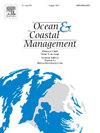Improving the level of land‒sea coordination: An integrated framework for identifying and assessing conflicts in coastal areas
IF 4.8
2区 环境科学与生态学
Q1 OCEANOGRAPHY
引用次数: 0
Abstract
Urbanized coastal areas face both resource-use and spatial conflicts as a result of rapid development. To improve the level of land‒sea coordination (LSC), a new integrated framework is proposed in this paper for identifying and assessing conflicts, which are termed "point-line-surface" conflicts, on the basis of morphological characteristics. Point conflicts are focused on conflicts in reality, while the other conflict types involve potential conflicts in spatial planning. Drawing upon diverse sources of statistical data concerning land and marine use survey results and spatial plans, we use a general conflict matrix, a geographic grid approach and spatial data analysis to quantitatively measure the intensity and spatial distribution of coastal conflicts. A case study in Laizhou, a county-level coastal city in China, is used to demonstrate this framework. The results show that point conflicts mainly exist between water and wetlands (UWW) and fishery (UF) and between industrial and mining (UIM) and UF. Line conflicts show that the conflict between marine spatial planning (MSP) and urban spatial planning (USP) is greater than that between land spatial planning (LSP) and USP, and surface conflicts indicate that functional zones with high externalities are mainly concentrated near central towns and industrial clusters. The optimization of existing land and ocean use patterns and the coordination of different spatial plans might serve as effective approaches for improving LSC in coastal areas.
提高陆海协调水平:确定和评估沿海地区冲突的综合框架
沿海城市化地区由于快速发展而面临着资源利用和空间冲突。为提高陆海协调水平,本文提出了一种基于形态特征的陆海冲突识别与评估新框架,即“点-线-面”冲突。点冲突集中于现实冲突,其他冲突类型涉及空间规划中的潜在冲突。利用不同来源的陆地和海洋利用调查结果和空间规划的统计数据,我们使用一般冲突矩阵、地理网格方法和空间数据分析来定量衡量沿海冲突的强度和空间分布。本文以中国沿海县级市莱州为例,对该框架进行了实证研究。结果表明:水与湿地(UWW)与渔业(UF)、工矿(UIM)与工矿(UF)之间存在点冲突;线冲突表明海洋空间规划(MSP)与城市空间规划(USP)之间的冲突大于陆地空间规划(LSP)与城市空间规划(USP)之间的冲突;地表冲突表明外部性高的功能区主要集中在中心城镇和产业集群附近。优化现有的土地和海洋利用格局,协调不同的空间规划,可作为改善沿海地区土地和海洋利用的有效途径。
本文章由计算机程序翻译,如有差异,请以英文原文为准。
求助全文
约1分钟内获得全文
求助全文
来源期刊

Ocean & Coastal Management
环境科学-海洋学
CiteScore
8.50
自引率
15.20%
发文量
321
审稿时长
60 days
期刊介绍:
Ocean & Coastal Management is the leading international journal dedicated to the study of all aspects of ocean and coastal management from the global to local levels.
We publish rigorously peer-reviewed manuscripts from all disciplines, and inter-/trans-disciplinary and co-designed research, but all submissions must make clear the relevance to management and/or governance issues relevant to the sustainable development and conservation of oceans and coasts.
Comparative studies (from sub-national to trans-national cases, and other management / policy arenas) are encouraged, as are studies that critically assess current management practices and governance approaches. Submissions involving robust analysis, development of theory, and improvement of management practice are especially welcome.
 求助内容:
求助内容: 应助结果提醒方式:
应助结果提醒方式:


